Welcome to Slawi Bay, Komodo, Indonesia!


What a beautiful serene landscape as we pulled into Slawi Bay. The rugged mountains rose up out of the water and were the most vivid green you could imagine. The beauty of this place is hard to describe, because it is so unspoiled and ancient and because today the overcast skies lent a magic to the light from the time we arrived till the time we departed. If one ever wondered what Jurassic Park might have looked like this would be a mini version.
The population is primarily Muslim, but Christianity and Hinduism are also practiced. Komodo is one of the 17,508 islands that make up the Republic of Indonesia, and is part of the Lesser Sunda chain of islands and forms part of the Komodo National Park.
The Komodo dragon, a type of monitor lizard, is the world's largest and roams the island freely. It also makes its home on some of the smaller surrounding islands. The lizards grow to an average of between 6 and 10 feet long and weigh an average of 150 pounds (70 kg). The dragon's diet consists mainly of carrion, but they will hunt and ambush birds, invertebrates and mammals.
Komodo dragons were discovered by Western scientists in 1910 and caused a sensation in zoos all over the world. Komodo National Park founded in 1980, includes the three larger islands Komodo, Rinca and Padar, as well as numerous smaller ones, and was established in order to protect the dragons. It has since become dedicated to the protection of other species, including marine species. It has been a UNESCO World Heritage Site since 1991. Although the Komodo dragon is the undeniable star attraction, scuba divers come from all over the world to marvel at the diversity of species that can be seen in the waters around these volcanic islands. We arrived around 9:30 into a large protected bay or harbour which is surrounded by the lush green volcanic mountains.
In order to get to this island, we had to anchor in the middle of the bay and tender into port. Since you are not allowed on the island without a guided tour, we had to be called in groups, ride the tender over and then met a guide, a park ranger and more men armed with "weapons" in case of a Komodo attack!
The "weapons" that were used were branches of a tree that had a Y shape at the one end!
So we arrived and had to walk up a rickety walkway to the beach. Right as step on the beach, you enter Komodo Dragon National Park.
Sitting at the entrance are the many men armed with their sticks, waiting for a group of people. We felt like we not only saw dinosaurs today, but also the natural habitat in which they lived.
The mountains look plush with green, and as with other places where there is no human habitation visible, the scale is hard to judge.
The tops of the mountains are studded with tall trees that stand out on the horizon. Some mountains look like they are covered with giant moss, but this is an illusion as it is likely jungle.
Aside from its most famous residents, the Komodo Dragons, the inhabitants of this island are mostly descendants of former convicts, exiled to the island and have mixed with the Bugis from Sulawesi.
We tour a 3 hour trek through the National Park. This is the rainy season, and it had rained in the night and as we sailed in the skies were overcast, but it was typically Indonesian humidity in the air, and we were grateful not to be going into a blazing hot sun. At the entrance they warned you be be quiet when walking, not to look the dragons in the eyes, and if they attack not to run but walk quickly!!! This was the path and surroundings!
There were many of us who were nervous about our dragon encounters because our guide told us that there are about 1088 dragons in the park! We had been told that no menstruating women could come ashore as the dragons can smell blood more than 5 miles away and would attack. I also had to take a second shower before we went because we had also learned no scent of any kind and I had put on sunscreen. Apparently musk smells like Brut aftershave excite them as well. We were told that the dragons strike their prey and inject them with venom and then they wait for about 4 days for that to kill them!
Armed with this information our group of 20 set off for a trek through the muddy jungle. Our guide told us to keep together and to be silent. The dragons are camfloage in color and therefore we were constantly on the lookout. Also the baby dragons can climb trees! So you were always looking side to side, up and down and all around!
He told us about the daily cycle of the dragon. They are cold blooded so they rise at 6 am. and sit in the sun for an hour or so to warm their blood, then hunt till noon, then rest till 3, then hunt till dark, when they become blind and cannot see after dark. Luckily our tour went at 1:00!
Dinner!
As you walked through the park, you could hear birds overhead and see deer in the woods - hopefully they will not be the Komodo's dinner tonight!
Of course some people didn't listen and talked very loudly. After a 20 minute walk we arrived at the watering hole. There were 2 very large dragons apparent to me at first and it took me the whole time I was there to "see" them all as they are so still and so camouflaged. They were very alert to our presence - one guy had his head held high and their tongues were out, which is how they smell. Jeff took some great pictures that showed the length of the dragon's tongue and also of ones charging him!
Look out, Jeff!
Keeping the Dragons away!
A smaller (5 ft) immature dragon was seen crossing the path that we had just walked on to get there. These guys are really primitive, huge and scary and can run at 12 miles an hour for short distances!
We were there about 15 minutes and by now everyone was silent. We learned later down the return path that this was a bit staged as the 1088 dragons that live wild on the island roam freely and in order to make sure our ship saw them, they had dragged dead meat into the watering hole to attract them. They are not artificially fed, and the natural balance is maintained, by letting them hunt the wild pigs, deer and wild chickens. They can completely down a pig in 25 minutes and it sits in their slow digestive system for 1 month. The female lays about a dozen eggs and the males fight to mate with the female of his choice.
We continued to walk along the path, found some lemongrass, then entered a small village.
I went over to one of the houses and there was a female komodo dragon just laying down beside the house - while people were outside!!! I guess if you live with dragons all your life, you just get used to it!
The house!
The Komodo beside the house!
Me and the Dragons in the back!
Then we went to the market that was set up that day just for us! Men from the village were selling handmade Komodo dragons, other dragon artifacts, teeth and claw nails from dead dragons, as well as pearls that were from the area. There are only 3000 people that live here and although we could only see their town by zoom lens, we truly felt sorry for the fact that all they have to support themselves are these dragons. The interesting part was that each guy was selling the same exact things and each guy was very determined to sell you their wares. Some tenacious vendors followed our tender right to the ship, and bargained with all of us through the tender opening as we boarded the ship! They even had children pushing you get you to buy! One has to ask how many ships ever come here and it is once again a reminder of how truly privileged we are with the opportunities for employment that we have in the Western world and how impoverished most of the world is. We walked along the beach, Komodo Dragon free, and then headed back to the ship on the tender!
Our sail-away was marvelous as the light and the clouds once again provided those layers of hills. We even saw a huge thing jump out of the water twice and someone said it might be a stingray. Overall, it is surely paradise for wildlife, both on land and in the sea, but probably not so for humans as the only industry seems to be tourism centered on walking for an hour to see the dragons, and then hoping they will buy the trinkets in the market. We set sail on time for the port of Lembar, in Lombok, Indonesia which is across a small strait from Bali.
As we boarded our ships, boats of men came to the entrance trying to sell us last minute goods!
Even the kids were selling!
Tonight we had a Really Full Table - 12 people at our table for dinner - a real squeeze. The Captain, Karen, Linda, and Gary joined us, as did David and Karen who teach bridge on the ship - and guess what, David helped put the Man on the Moon!
A Komodo(?) Skull!








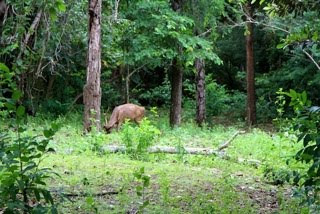













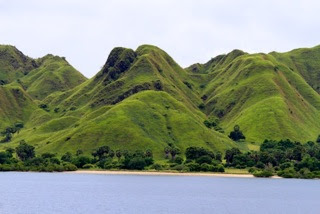








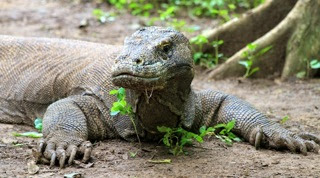












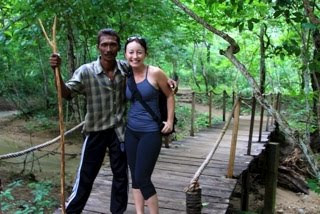



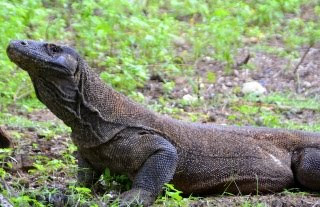

















No comments:
Post a Comment